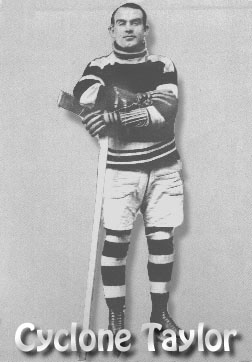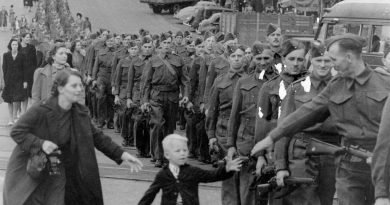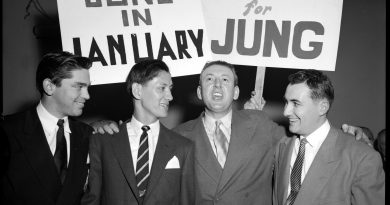1979
Above: Former premier W.A.C. Bennett. He died in Kelowna, aged 78.
[Image: Vancouver Sun]
*****************************************
You’ll note that these years include events listed under “Also in . . .” These are events for which we don’t have a specific date. If YOU know the specific date of an event shown there, please notify us . . . and cite the source! Many thanks!
*****************************************
February 23 Former premier W.A.C. Bennett died in Kelowna, aged 78. See a good brief biography here and listen to an interview with Bennett conducted by Jack Wasserman, then with the CBC, here.
May 10 The Social Credit party was re-elected under Premier Bill Bennett.
May 22 The Vancouver Sun won a long-running case against GATE, publishers of Gay Tide newspaper. It began in the mid-1970s when the Sun refused to run a two-line classified ad promoting Gay Tide. GATE had won a B.C. Human Rights Commission complaint and a subsequent challenge by the Sun in B.C. Supreme Court, but the decision was reversed in the B.C. Court of Appeals. Finally, the Supreme Court of Canada ruled in the Sun’s favor.

(Photo: Cyclone Taylor Sports)
June 9 “Cyclone” Taylor, OBE, hockey player, died in Vancouver, aged 95. Frederick Wellington Taylor was born June 24, 1883 (or was it 1884, or 1885?) in Tara, Ontario. He played with the Ottawa Senators in 1909 when they won the Stanley Cup, was the key player with the Vancouver Millionaires when they won the Cup in 1915. (They beat Ottawa in three straight games, during which Cyclone scored seven goals.) It was his speed on the ice that earned him his nickname. When Taylor joined the Pacific Coast Hockey Association in 1913, it gave the new league the credibility it needed. He played for Vancouver from 1913 to 1921, then retired. One of the great hockey players, he scored 194 goals—or was it 205?—in 186 games.
During his professional hockey career Taylor was also employed by the Immigration Department. On his retirement he was Commissioner of Immigration for British Columbia and the Yukon Territory. He was president of the Pacific Coast Hockey League from 1936 to 1940 and helped form the British Columbia Hockey Benevolent Society, which he served as director from 1954 until his death. He is, of course, in Canada’s Hockey Hall of Fame.
His oldest son, Fred, started Cyclone Taylor Sports in Vancouver, a retail outlet for sports equipment, in 1957.
June 16 Richmond celebrated 100 years since incorporation as a municipality and honored its pioneers who had lived in the community for more than 60 years.
July 12 Granville Island Public Market opened, and became an immediate hit, one of the great Vancouver experiences. Some 10.5 million people visit every year now, and a big chunk of them go to the market. Denny Boyd raved about it in his Vancouver Sun column the day after the opening. “I want to be able to poke a red snapper in the gills. I want to hear a good trumpet player blow a couple of choruses of Yellow Dog Blues while I’m looking at the scallions. Dammit, I want to buy a warm cookie.”
The market is in a building erected by the Island’s very first tenant (1916), B.C. Equipment Ltd. Part of the offbeat charm of that building is the travelling cranes that hang from the rafters, kept by the architects. The Island’s architecture has won design awards for Hotson Bakker, the coordinating architects, and others who worked on various projects.
This site has a wealth of photos of the island by the indefatigable Maurice Jassak.
August 6 Surrey Council “invites one and all” to the city’s 100th Birthday Party Centennial Week at Bear Creek Park.
August 12 The Province first appeared on a Sunday.
August 16 Population growth in Coquitlam had been shifting north to Eagle Ridge in the late 1970s. Today, in response to that, Coquitlam Centre opened at 2929 Barnet Highway. It was “bordered by bush, a trailer park and houses scattered amid trees.” The centre would win the Governor General’s Award for Excellence in Architecture in 1982 for Edmonton architect B. James Wensley. A collection of 27 sculptures and other art work by B.C. artists at the Centre also garnered praise.
August 22 The Village of Belcarra was incorporated. It covers just over five-and-a-half square kilometres, and the population is an estimated 2,000. It’s policed by the Coquitlam Detachment of the RCMP, and there is the Sasamat Volunteer Fire Department:
August Richmond hosted the three-day 1979 B.C. Summer Games, the first to include disabled athletes.
August Kent Prison in Agassiz opened. This maximum security institution houses 313 (original capacity 234) prisoners. Inmates are kept under a constant level of high surveillance. More than half of the prison population are housed in the protective custody wing, separated from the regular population for the duration of their sentences.
September 1 Barry Downs and Richard Archambault, architects, went into business as Downs Archambault & Partners.
September 8 The Vancouver Whitecaps pounded out a dramatic win over the Tampa Bay Rowdies in New York to win the North American Soccer League Championship. Trevor Whymark scored both goals (one off each foot) in Vancouver’s 2-1 victory. “Whymark has been,” Jim Taylor wrote, “the catalyst, the trigger, the missing piece in the marvellously improbable soccer story that has taken Vancouver by the heart and squeezed it as no other sports event has before.”
John Craven (Defensive Player of the Game) and Alan Ball (Most Valuable Player of the Playoffs) were also singled out for special mention.
100,000 fans greeted the team on its return.
September 27 Vancouver street photographer Foncie Pulice took his last picture. Foncie and his Electric-Photo camera had been a familiar sight on city streets for a jaw-dropping 45 years. He’d begun as a 20-year-old away back in 1934 as an assistant to street photographer Joe Iaci, and had taken millions of photographs since. (It is quite possible Foncie Pulice photographed more people than anyone who ever lived.) “I said I’d retire at 65, and I kept my word,” he said in a November 21, 1979 interview in the Province.
Did he save all those millions of negatives? They’d likely be worth a small fortune now. “I never did,” he said. “I didn’t really think about it at the time. I’d keep ’em for a year, then throw ’em out. I realize now I should have saved them, but it’s too late.”
People even made appointments for street pictures! “Oh, yes. They’d phone ahead and tell us what time they’d be walking down Granville. Dr. Peter Bell-Irving had members of his family photographed every year. I have shots showing one little tyke in that family growing all the way up to six-foot-five.”
Foncie’s camera, made of war surplus materials, is preserved at the Vancouver Museum. It’s part of their 1950s gallery, and is accompanied by a slew of Foncie’s Fotos.
All across Canada and in other countries there are thousands and thousands of Foncie’s Fotos, showing thousands and thousands of people striding along the street, captured in motion in unposed moments that may be closer to the spirit of the people shown than any carefully composed studio portrait.
Foncie Pulice was the last of the street photographers. He died January 20, 2003 at age 88, but his work lives on . . . everywhere.
September 15, 16 and 18 Kent, the leading English county team of the 1970s, visited Vancouver to play three one-day games at Brockton Point against local teams. (If you know the scores, please contact us here.)
September George Wootton ended his tenure as principal of Douglas College. He was the college’s first principal, starting in August 1969.
October 27 The last scheduled passenger train departed from the CPR station at the foot of Granville Street. Trains had been arriving and leaving from this handsome building since 1914. The cliche is irresistible: It was the end of an era. For 67 years the handsome building had been the site of arrivals, reunions and farewells. I first saw Vancouver from this building, having just arrived from Winnipeg with my father in December 1944. My first visual memory of the city was of the First World War statue in front of the station depicting an angel lifting a fallen soldier into heaven. That statue is still there, with later wars added to its words of dedication.
There was disappointment that Via Rail’s passenger service would operate from the CN Station on Main Street. “The CN is just a barn,” train patron George Copeland told The Province. “This place has got character.”
Station baggage master Doug Taylor had worked there for 39 years. When he started in 1940, Taylor said, the baggage department had 100 employees. On this last day it had six. The building still has character. It’s been beautifully restored as thousands of SkyTrain, West Coast Express and SeaBus patrons well know.
October 28 Chuck Davis’ columns on local history began to appear in The Province’s Sunday editions. In all, there were 194 of them, then the paper went tabloid.
October Presentation House on the North Shore presented Eric Nicol’s two-act comedy, Free at Last.
November 6 Burnaby council voted itself a 7.5-per-cent wage increase, bringing its total increases over two years to almost 30 per cent.
December 16 The Steveston Museum opened in a 1905 building, which had been a bank, then a doctors office. The Steveston Historical Society also operates a post-office there.
December 21 In The Province Consumer Alert columnist Chuck Poulsen wrote, “In a month or so, supermarkets should be serving up a large batch of rabbits for sale. Chinese rabbits. For Canada Packers, it will be the first test run of the low-cost, imported rabbits which are expected to sell for about half the price of the B.C. bunnies. The Chinese rabbits will be coming at a time when a government survey predicts that we’d eat rabbits faster than they multiply if there was a reasonable supply and the price wasn’t too much higher than chicken.”
Also in 1979
Art Cameron, Resident Manager at the Hotel Vancouver for decades, retired. What made Art—born in January, 1910 in New Westminster—distinctive was his style: he was a naturally funny guy, a never-exhausted font of sly humor and wicked ripostes. How many hotel managers are also gag writers? Art wrote gags for Bob Hope (a lifelong friend), Jack Benny, Edgar Bergen, Phil Harris, Ed Gardner, Alan Young and others. Among the more notable events of his long career: he was manager of the Sylvia Hotel in 1959 and was one of the guests at the West End apartment death October 14 of that year of screen star Errol Flynn.
The Office of the Ombudsman was established by provincial legislation. The Ombudsman receives inquiries and complaints about the practices and services provided by public bodies. He or she can investigate to determine if the public body is being fair to the people it serves.
Tsutae and Hanako Sato, who together ran the Vancouver Japanese Language School (from 1906 to 1942), established scholarships in Japanese studies at UBC. In 1978 Tsutae Sato was awarded the Order of Canada.
Ballard Power Systems was created. Dr. Geoffrey Ballard developed the fuel cell technology that led to the creation of the company, but would leave it in1997. In 1999, with Paul Howard, he would form the company General Hydrogen. Time Magazine would name him a Hero of the Planet in 1999. He said, at a recent conference, “It will take a combined effort of academia, government, and industry to bring about the change from a gasoline economy to a hydrogen economy. The forces are building and progress is being made. It is of major importance that a change of this magnitude not be forced on unwilling participants, but that all of us work together for an economically viable path to change.”
The wooden auxiliary schooner Maple Leaf began to provide educational/environmental cruises between the Gulf of Georgia and Alaska. She is the oldest B.C. vessel in the Canada Registry of Ships. She was built at Vancouver Shipyard in Coal Harbour in 1904 for lumber baron Alexander McLaren, and was the first vessel to fly the colors of the Royal Vancouver Yacht Club in an open race. (From 1916 to 1979 she was used in the halibut fishery under the names Constance B and Parma.) See this website.
The provincial government sold the buses it inherited from the BC Electric Company to Pacific Coach Lines.
Hassan Khosrowshahi and his family fled Iran during the Ayatollah Khomeini unrest and came to Vancouver. He opened a small office equipment shop on West Broadway. In 1983 he will incorporate Future Shop Ltd. and build it into a giant Canadian enterprise, employing more than 10,000 people in 90 locations across Canada.
Harold Lenett, a Vancouver businessman, approached the Levi Strauss company with an offer to make leather jackets, but was asked to make denim instead. He borrowed $5,000, bought some used Levi equipment, and launched Pimlico Apparel Ltd. Today, the company is North America’s leading denim jacket producer, supplying Levi Strauss and The Gap from a 75,000-square-foot factory.
Maureen Drew, Executive Director of Apparel BC, an industry trade group, and other industry leaders launched the Western Canadian Designers & Fashion Association. To quote the website: “WCDFA has been on the leading edge of networking in the Canadian fashion industry. Founded in 1979, this association is the oldest functioning design and fashion association in Canada. Geographically WCDFA included professionals from Alberta, Saskatchewan, Manitoba and British Columbia. Their aim was ‘to create a professional organization to benefit and reflect the talent of fashion designers in Western Canada.’ The WCDFA presents an annual fashion event called the ‘Designer Showcase’ and sponsors fashion related events at western colleges and universities.”
Svend Robinson was elected MP for Burnaby-Douglas, the youngest member of the NDP caucus (born March 4, 1952).
Pauline Jewett was elected as an NDP Member of Parliament for New Westminster-Coquitlam. She will serve in that capacity until 1988.
George Laverock became the producer for programs featuring the CBC Vancouver Orchestra, and the orchestra would go on to become the most recorded in Canada.
Central Mortgage and Housing Corporation got a new name: Canada Mortgage and Housing Corporation.
Vancouver city council reinstated Joe Philliponi’s licence to run the Penthouse. On December 31, 1975, the club had been closed by the vice squad, and in 1977 Philliponi was charged with living off prostitution but the conviction was quashed.
These books appeared in 1979. Details on their writers can be found at www.abcbookworld.com.
Son of Socred, by Stan Persky. Persky’s first book asked in its subtitle: Has Bill Bennett’s Government Gotten BC Moving Again?
Exploring the Coast by Boat, by Freda Van der Ree, was a comprehensive guidebook to 51 boating areas in the Strait of Georgia and Puget Sound. It has had numerous printings since this first appearance. Van der Ree travelled extensively with her family, both under power and under sail, in both summer and winter.
The Delta Centenary, 1879-1979: a Pictorial Review of Delta’s First One Hundred Years Corporation of Delta.
Above the sand heads: first hand accounts of pioneering in the area which, in 1879, became the Municipality of Delta, British Columbia Narrated by T. Ellis Ladner; prepared for publication by Edna G. Ladner.
Richmond, Child of the Fraser by Leslie J. Ross under the direction of the Historical Committee of the Richmond ’79 Centennial Society
Saints: The story of St. George’s School for Boys by Douglas E. Harker.
Empire of Time, the first in Crawford Kilian’s Chronoplane Wars science fiction trilogy. It was described by one reviewer as “a nifty page turner about a physically and mentally augmented James Bond type.”
Michael Walsh, long-time film critic for The Province, gave us The Canadian Movie Quiz Book.
The late L.R. “Bunny” Wright was Canada’s leading female author of mysteries. Born in Saskatoon in 1939 and raised in Abbotsford, she left a newspaper job in Mission to work for major newspapers in the prairies. She received the Alberta First Novel Award this year for Neighbours. Her major successes ahead will be mysteries set on the coast featuring RCMP officer Karl Alberg.
Raincoast Books was established. This company would, in the future, gain the rights to Canadian publication of the Harry Potter books. That would turn out rather well for them. See this site.
Several periodicals began in 1979:
International History Review, a quarterly from Simon Fraser University, examining relations between all states throughout history
Musick, a quarterly produced by the Vancouver Society for Early Music. It covers medieval, Renaissance, baroque and classical music
Uptrend: Canadian Penny Market Newsletter was published every three weeks by Yorkton Continental Securities Inc.
Wildlife Rescue, a quarterly for members of the Wildlife Rescue Association of British Columbia. It reviews the organization’s activities in wildlife rehabilitation and education.
The movie A Man, A Woman And A Bank, directed by Noel Black, is described by Michael Walsh as “a caper comedy with a Gastown setting. Its focus is on two high-tech robbers (Donald Sutherland, Paul Mazursky) and the non-technical distractions provided by a local beauty (Brooke Adams).”
The movie Prophecy, directed by John Frankenheimer, appeared. Wrote Michael Walsh: “Though caused by industrial pollution, the horrific mutations that an environmental scientist (Robert Foxworth) encounters in the Maine woods also fulfill local Native American legends.”
The Internet Movie Database says about this movie: “Filmed in British Columbia in 1978, Prophecy marked the beginning of ‘Hollywood North,’ the major start to the development of a massive film production business in Vancouver and other parts of the province of British Columbia, in Canada. Since then hundreds of ‘American’ movies have been filmed in the Canadian province.”
Bird of Spring, a bronze sculpture by Etungat, an Inuit artist, was placed at Robson Square (on the stairway near the Art Gallery). The sculpture is a recreation of a tiny 14-cm original by Etungat.
The 460-seat Arts Club Theatre: Mainstage opened at 1585 Johnston Street on Granville Island.
The Arts Club became one of the earliest landmarks on Granville Island and a personal triumph for Managing Director Bill Millerd who had always dreamed of having a theatre on the waterfront. Now the theatre is home base for a company with three theatres and an adjoining lounge. The company regularly tours its shows throughout the province.
The 240-seat Waterfront Theatre opened at 1410 Cartwright on Granville Island. This was originally the home of Carousel Theatre, the New Play Centre (now Playwrights Theatre) and the now defunct Westcoast Actors. The Waterfront is now primarily a rental venue and home to Carousel, which produces three shows for family audiences each year.
The David Y.H. Lui Theatre, opened by Lui in 1975, closed. During its brief, but notable, life theatre goers enjoyed major appearances by Dame Joan Sutherland, the National Ballet of Canada, The Royal Winnipeg Ballet and others. Today, the building is a nightclub, Richard’s on Richards.
With the departure of Freddie Long, Mauryne Allan became sole head of Mountain Dance Theatre, which had started as Burnaby Mountain Dance Company in 1973 at Simon Fraser University. The company had moved off-campus in 1975 under the joint direction of Allan and Long.
Arts Umbrella began. To quote its web site: “Since our inception in 1979 with only 45 students, Arts Umbrella has grown to now reach more than 30,000 young people annually. Our Granville Island facility hosts more than 260 classes each week, ranging from general courses to pre-professional training in theatre, dance, painting, sculpture, architecture, film, new media, photography, and more.”
A study showed that Surrey had become “Vancouver’s bedroom,” as more than 50 per cent of its residents worked elsewhere. In 1879 almost everyone who lived in Surrey worked there.
Vancouver’s new courthouse and Robson Square complex, designed by Arthur Erickson, was completed. The complex changed the face of downtown.
North Vancouver High School closed, having served the community for 69 years. On the closure of the school the new gym, named after Principal Mickey McDougall, became part of the North Vancouver Recreation Centre.
The provincial government finally officially recognized the name “The British Properties,” long after it appeared on district maps.
In White Rock Tom Kirstein, a chartered accountant, and a friend, Chip Barrett, wondered aloud: why not have a sandcastle competition? That led to White Rock’s famous Great Canadian Open Sandcastle Competition. With prizes amounting to $10,000, and scores of teams competing, the annual event drew international attention, attracting crowds estimated at 150,000 to the waterfront. Unfortunately, by 1987, community dismay at the crush of people, unruly elements, and rising police costs would force the cancellation of the competition.
Greenpeace began to go international. Greenpeace organizations in Australia, Canada, France, Holland, New Zealand, the United Kingdom and the United States formed Stichting Greenpeace. Today, Greenpeace International is headquartered in Amsterdam.
Elisabeth Hawley and her three grandchildren willed Haney House to Maple Ridge. Elisabeth was the daughter of Thomas and Annie Haney, area pioneers, after whom Haney—now a part of Maple Ridge—was named. The house, at 11612 224th Street in Maple Ridge, was built in 1878. It has been restored as a museum, and displays many furnishings and artifacts used by three generations of the Haney family.
The International Plaza Towers were built, at 71.6 metres and 26 storeys the tallest buildings in North Vancouver District.
Nathan T. Nemetz became Chief Justice of British Columbia. He will hold the post until 1988.
In 1979, the provincial government, in part prompted by the dire situation facing refugees from Southeast Asia, passed a special act to help refugees resettle in B.C.
George Pedersen became president of Simon Fraser University. He will hold the post until 1983. During his tenure part-time studies for mature students and the school of engineering science, which concentrates on new technology, began. He also launched cooperation with BCIT to establish downtown classes in rented office space.
The Continuing Education Division of Vancouver Community College introduced a Court Interpreting program, the first of its kind in Canada.
A totem pole carved by Don Yeomans, a Haida native and a graduate of Langara’s fine arts program, was erected near the college’s main entrance.
Terry Fox began to participate in a in a wheelchair-basketball team, after being recruited by Rick Hansen. Part of Terry’s self-designed exercise routine was pushing his chair up Gaglardi Way, a long, steep climb up Burnaby Mountain toward Simon Fraser University at the top.
Police seized a little brown book at the apartment of a well-known Vancouver prostitute. In it were 800 names of men, a who’s who of high society, including a high-ranking member of the B.C. judiciary. Wendy King pleaded guilty to keeping a bawdy house and was fined $1,500. But the notebook was sealed by a B.C. Supreme Court Judge, the names never revealed.

![W.A.C. Bennet [Image: Vancouver Sun]](https://vancouverhistory.ca/wp-content/uploads/2021/01/july-31-1964-w-a-c-bennett-at-the-ceremony-marking-the-con-800x445.jpeg)


